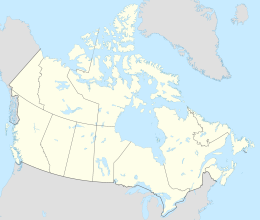Island in Nunavut, Canada
Maittuq , formerly Anarnittuq Island, is a small uninhabited island, approximately 44 km (27 mi) south of Naujaat in the Kivalliq Region of Nunavut , Canada. It is located towards the north end of Roes Welcome Sound , just offshore of the Canadian mainland, where it meets Frozen Strait .
To the south lies Southampton Island and the community of Coral Harbour .
Climate
Naujaat t0 the north has a tundra climate (Köppen ET ) with short but cool summers and long, cold winters.
Climate data for Naujaat (Naujaat Airport )66°31′17″N 86°13′29″W / 66.52139°N 86.22472°W / 66.52139; -86.22472 (Repulse Bay Airport )
Month
Jan
Feb
Mar
Apr
May
Jun
Jul
Aug
Sep
Oct
Nov
Dec
Year
Record high humidex
−4.6
−11.6
−2.1
2.4
7.9
21.1
29.3
21.9
15.4
4.2
0.4
−1.0
29.3
Record high °C (°F)
−1.7
−6.1
−1.5
3.5
8.0
22.5
28.0
23.0
15.5
4.0
0.0
1.1
28.0
Mean daily maximum °C (°F)
−27.5
−27.5
−22.1
−12.6
−3.2
6.4
13.6
10.7
3.4
−3.7
−15.1
−21.4
−8.2
Daily mean °C (°F)
−30.7
−30.8
−26.1
−16.7
−6.5
3.2
9.1
7.1
1.1
−6.4
−18.7
−25.0
−11.7
Mean daily minimum °C (°F)
−33.6
−33.8
−30.0
−20.9
−9.7
−0.1
4.7
3.5
−1.3
−9.2
−22.2
−28.5
−15.1
Record low °C (°F)
−47.8
−50.0
−45.0
−40.0
−29.0
−11.0
−1.0
−3.0
−11.5
−31.0
−42.0
−46.0
−50.0
Record low wind chill
−66.0
−64
−59
−50
−30
−19
0
−8
−18
−41
−50
−59
−66
Average precipitation mm (inches)
22.1
18.0
21.6
26.7
18.6
24.7
31.1
49.5
36.0
31.6
27.6
21.3
328.7
Average rainfall mm (inches)
0.0
0.0
0.0
0.4
2.5
19.1
31.1
48.5
25.2
2.1
0.0
0.0
128.9
Average snowfall cm (inches)
22.5
22.5
25.0
30.0
19.4
5.2
0.0
0.9
12.1
35.5
31.7
24.8
229.5
Average precipitation days (≥ 0.2 mm)
10.4
7.6
11.9
10.1
9.5
9.1
9.7
12.2
11.9
14.7
11.2
9.9
128.1
Average rainy days (≥ 0.2 mm)
0.0
0.0
0.0
0.22
1.1
7.4
9.7
12.1
7.8
0.89
0.0
0.1
39.1
Average snowy days (≥ 0.2 cm)
10.3
8.2
12.5
10.8
9.2
2.4
0.0
0.33
4.9
13.9
11.7
10.2
94.5
Source: Environment and Climate Change Canada Canadian Climate Normals 1991–2020[ 2] [ 3]
References

